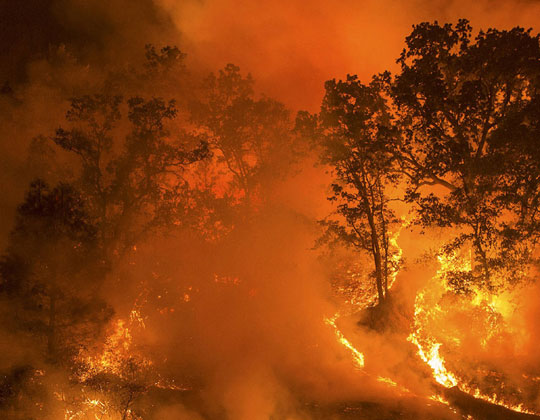As of Monday, the wildfires consuming the West Coast are reported to be only 32 percent contained, according to NY Times. California and Oregon are known to have experienced the most damage, with Idaho following closely behind. It is reported that haze from the fire has been seen as far as New York and Washington, D.C., demonstrating widespread impacts as a result of the blaze. According to CNN, roughly 90 active wildfires remain, and are destroying everything in their paths.
What is making this nearly impossible to contain, one may ask? This challenge is a product of the shifting winds and, record heat, and dry climate. Many believe that this is a result of the changing climate, in which approximately 4.6 million acres of land has been consumed in 10 different states, California remaining the most at risk with at least 25 active fires. President Trump recently visited McClellan Park, CA, responding to the crisis where 363,000 acres recently burned. He refused to explain the wildfires as being a result of climate change, rather stating that it is due to the poor forest maintenance. Environmentalists state that the ravaged land and clouds of ash are a result of Trump’s avoidance of climate change and rollback on environmental regulations. Professor Pettengill, an environmental studies professor here at St. Lawrence elaborates upon this, stating that, “the argument that wildfires are the result of mismanagement as opposed to climate change is a false one, and one more example of polarization of our nation.” He further explains that over time, “the paradigm in wildland firefighting for decades was to put all fires out at all costs,” and as a result, “this has led to substantial amount of fuel left on forest floors that may have burned under natural conditions.” This has led to a change in approach to fighting wildfires over time, in which Pettengill points out that, “it takes very specific conditions to conduct these operations safely.”
Professor Pettengill further explains the impacts of climate change, reinforcing the understanding that researchers are perpetuating to the public in regard to climate change. He states,
the impacts of climate change, including increased aridity in many parts of the West, only exacerbates these issues. The argument of mismanagement vs. climate change is an example of the tyranny of “or” Historic mismanagement ‘and’ climate change help explain issues regarding wildfires in the West today.
These lasting wildfires are evidently producing lasting impacts.Oregon is currently experiencing heightened crisis, in which support is being sent from as far as Michigan, according to Gov. Brown. Approximately 22 people are missing in Oregon and around 10 have been reported dead. People are ordered to evacuate throughout the West Coast not only to avoid the fires, but to prevent exposure to the harmful air. The air quality is currently the worst on the West Coast for all of Earth. This poor air quality is detrimental to those with preexisting breathing issues and can lead to the risk of lung infections, affect the immune system, and may increase the chance of COVID-19. Pettengill further explains lasting impacts beyond human health, explaining that,
lasting impacts are far-reaching and experts across many disciplines will be studying them for years to come. Impacts may range from adverse effects to public health from poor air quality, loss of wildlife habitat and timber resources, increased erosion and flooding, degradation of water quality, and irreparable damage to cultural and historic sites.
Slight improvements are expected by the weekend if weather permits, but rain is a crucial factor in a speedier end to the wildfires. Pettengill stresses the importance of how much of our public land is at risk, and that people back East should consider that the West’s problem is really our problem, for “public land belongs to all of us and therefore we should all take interest in these issues.”



